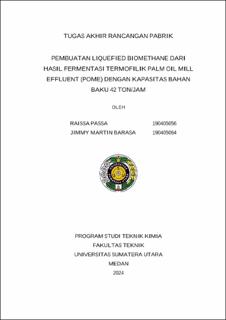Pembuatan Liquefied Biomethane dari Hasil Fermentasi Termofilik Palm Oil Mill Effluent (Pome) dengan Kapasitas Bahan Baku 42 Ton/Jam
Preliminary Plant Design of Liquefied Biomethane from Thermophilic Fermentation of Palm Oil Mill Effluent (POME) with Raw Material Capacity 42 Tons/Hour

Date
2024Author
Passa, Raissa
Barasa, Jimmy Martin
Advisor(s)
Trisakti, Bambang
Metadata
Show full item recordAbstract
Liquefied Biomethane (LBM) from biogas is currently in great demand as an alternative fuel. LBM is produced by fermenting organic materials followed by purification and liquefaction. The main objective of this factory design is to assess the feasibility of setting up a factory. Pre-design plant for the liquefied biomethane from Palm Oil Mill Effluent (POME) with an anaerobic fermentation process with a raw material capacity of 42 tons/hour and operates 330 days a year. The main process in the pre-design plant consists of four stages, namely raw material preparation, fermentation stage, purification stage, and liquefaction stage. This liquefied biomethane plant from POME is planned to be established in the North Penajam Paser area, East Kalimantan with a land area of 18,993 m2, the workforce required is 120 people with a Limited Liability Company (PT) led by a director with a line organization system. Establishment and operations require investment capital of IDR 2,144,021,466,315.83 and production costs of IDR 1,600,121,513,489.07. Based on feasibility analysis, this factory has a BEP of 33.91%, ROI of 30.65%, POT of 5,437 years. RON is 30.65%, and IRR is 19.94%. From the results of the economic analysis, it can be concluded that the pre-design of the plant liquefied biomethane production from POME by anaerobic fermentation is feasible to establish.
Collections
- Undergraduate Theses [1239]
